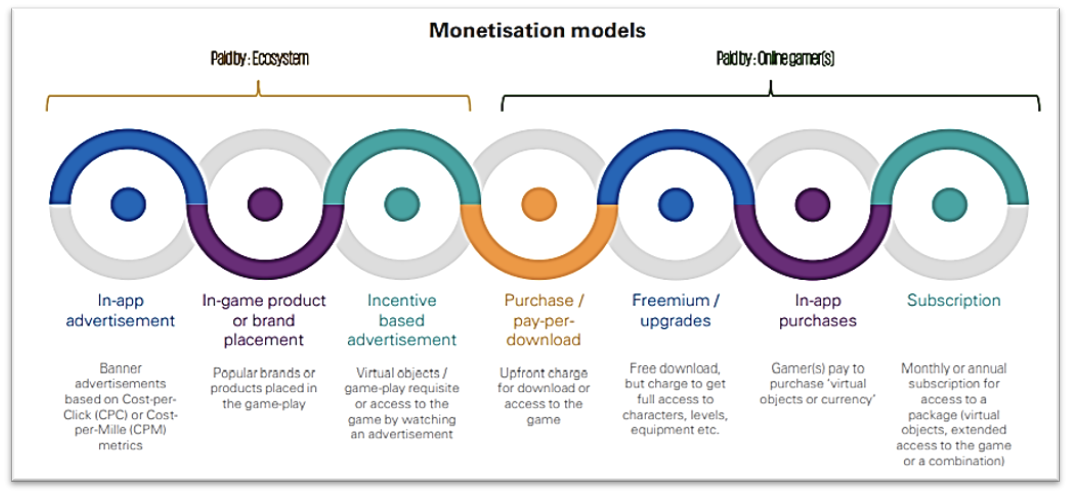Problems with the Gaming industry and the promise of Play to Earn games
Gaming is larger than the cinema and music industry put together. In this article, the first in a series, we explore some problems that this enormous industry faces and which blockchain could solve
Today, there are about 3 billion gamers in the world and this number has been steadily growing from about 2 Bn in 2015 at a rate of about 6% per year.
The video game industry is huge (~$ 3oo Bn) and while traditionally the industry has been dominated by large game development studios like Activision, EA, Ubisoft, etc there has been a huge rise to fame of smaller studios lately with the democratization of development, hosting and deployment infrastructure.
Take the red-hot gaming industry and match it with the super hyped world of NFTs and blockchains. Do you get something that would change the shape of both of these industries or something with a shallow foundation that creates more problems than it solves? Only time would tell.
Whether you agree with the prospect of having crypto in games or not, gaming is one of the few applications where there are legitimate pre-existing problems that are being aimed to be solved using the new capabilities of ownership tracking and trustless transactions that blockchain technology enables.
Problems faced traditionally by gamers and game developers
Ownership and value for the gamers
Gamers spend a substantial amount of their time and money on buying and playing games. This could stretch all from a few minutes a day, to fill the mundane time left in between activities, to more than 6-7 hours a day.
Even though the investment on the part of the gamers is huge they get no value out of the gaming ecosystem (barring the few streamers and e-sports stars).
Besides the direct investment of time and money, the gamers also are a significant value add to the community of the game and make the gaming experience more fun for others. Since multiplayer games are the stickiest due to their social aspect, helping develop the community as an early incumbent is a very crucial contribution towards the sustenance of the game.
Even though gamers contribute so much to the game, all the player progress, in-game assets, and value of the community. It only benefits the developers (who bag ~70% of game revenue) and the platforms that host these games (who get ~30% of the game revenue). The gamers see no part in what couldn’t have been sustained without them.
There is also a lack of direct motivation for the players to sustain the game community. It is very possible that the community of the game dies out and all the time and money invested into the game goes to 0.
The closed economy of games
In some games, players exchange the in-game assets within the closed economy of the game or through grey markets which often result in low price realization, the possibility of fraud, and limited liquidity.
Often you would see players trying to sell their game accounts with all their in-game possessions at arbitrary prices. There exists no open and permissionless market which can let players trade assets across different games and which facilitates a fair transaction. Closed markets that exist within games give entire control to the developers and they can charge transaction fees up to even 75%! (Roblox)
Also, the in-game assets are not interoperable which means that a player has to start ground up whenever they switch to a new game. All the value of a player's investment in the game is within the confines of that game.
The liquidity of these game assets is also questionable and one can see a major drop in case the game’s popularity is declining.
Developers do all the decision making
The developers have all the say in all decisions related to the game. The gamers are expected to adapt to all the changes that the developer pushes and a lot of which have little to do with making the game more enjoyable.
Even if the developers did want to take into account the opinion of the community, the game infrastructures to facilitate this are scarce. This leads them to frequently push very unpopular updates.
For all you know the game developer can take away all the progress you made, you get heartbroken and develop a ~$400 Bn blockchains like Vitalik Buterin
Developers need money to sustain the game
The developers are subject to a substantial amount of hatred for forcing the players to transact with them on a regular basis by offering them DLCs, expansion packs, season passes, loot boxes, etc. However, this is not entirely their fault. Players want the gameplay to improve, new elements to be added to the game, and for the game servers to run flawlessly.
Previously the business model of games used to be pay to play where the player was supposed to pay an initial sum in exchange for a game copy with which they can log onto the game and play. Then came the games that players wanted to play beyond completing the main storyline (like GTA V which is running for 9 strong years!).
These games usually had a strong community that made the players stick around for the social aspect of the game. Players socialize with their friends over the game or were found playing against random strangers every time giving them new strategies to beat each time.
However, running the game server, paying for the devs, and sustaining the innovation needs the gaming studios to maintain a continuous source of income and the initial upfront payments made by the gamers are not enough. This needs the developers either to abandon the game and let the community die or ask for micropayments in the form of DLCs, extension packs, etc.
The developers did not have a lot of options besides this constant nudge for microtransactions. It was largely either this or advertisements. The sale of in-game items even puts the game at the risk of having pay to play elements which means players could get an undue advantage over other players simply by paying more. Such elements ruin the experience of the game and make it less fun.
Then came the era of free to play games which no longer needed the player to pay any upfront amount to play the game. This format of games made it huge since there was no initial barrier to a player’s entry. Companies craved the stickiness of the users and their attention which could mean much more than the $20 - $40 price they would have otherwise made by selling the games upfront. This model has been the talk of the town of the gaming industry for the past few years with games like PUBG which has reached a 1213 Million player base.
The free to play games earn their revenues primarily through 2 sources: sale of game items or from the advertisement spends of companies. The popularity of this format of games is leading to majority of game revenue to come from virtual items as seen below
<Enter the world of blockchain>
Blockchains, which were built as the digitally native transfer of values, have enabled new economic and ownership models in the world of gaming.
A lot of crypto natives and Web 2.0 companies have jumped into blockchain gaming. This includes efforts like Ubisoft’s NFT collection and Adidas’ NFT partnerships to Binance’s $ 200 Mn fund for GameFi projects
Play and own
Blockchain lets players own their in-game assets and progress in form of NFTs, cryptocurrency, and governance tokens.
The players can prove the ownership of their game progress. This can be in the form of a rare character NFT that has the top-tier battle skills in the game or in the form of some rare collectible sword.
Blockchain also lets the community get back what it has collectively helped create including the value made from the entry of new players into the game or from the transactions made by the existing players. This could be in the form of yield-bearing governance tokens, special airdrops, appreciation in fiat value of the in-game currencies, or others. They also let the gamers make their opinions heard with the developers before any major changes are made to the game
Open Market
Putting the in-game assets of a game on the blockchain connects it to the highly developed (yet nascent) infrastructure of transfer of value established by blockchains like the NFTs marketplaces, crypto exchanges, etc. With this:
Each game developer is not required to develop the entire marketplace infrastructure again for their own game
Players are not required to do transactions on shady third-party marketplaces and pay high commissions
There is much more liquidity for in-game assets and the players can actually harvest their investment of time and money into the game
Players do not lose all value when they shift from one game to the other. They can sell off the assets from the first game and buy in the new one or use the same assets in the new game facilitated by interoperable NFTs
Helps the players realize more value on the sales since there is more open competition between the buyers
Helps developers try new monetization models
Blockchain helps the developers monetize their games in ways, not possible before. They can:
Earn from the secondary sales of in-game items and thus develop a steady source of income
Raise capital for the development of the game from the gamers who would be the first adopters of their game
Bootstrap the communities for their games by the offering rewards to the early players like a higher amount of governance tokens, NFT airdrops, etc
Increase the retention of players in the game by giving them monetary incentives to contribute to the community and create a better experience for other players
Though blockchain gaming is promising it is not without its own unique issues, like any new technology. We shall explore some of those and their solutions in the blogs ahead. We shall also see what are some of the latest innovations in this space and what they mean, especially for India.
Stay tuned for more!











